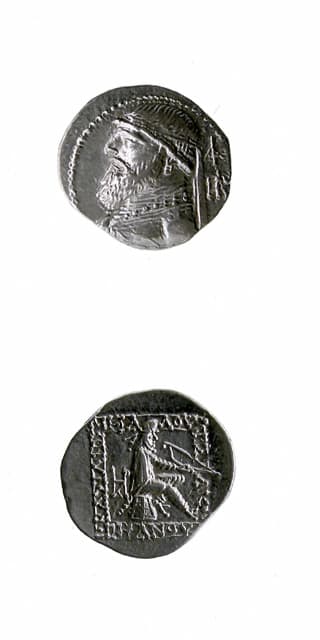Parthian Silver Drachm of King Mithradates II, 123 BCE - 88 CE
Silver
C.2287
Obverse: Bearded Portrait of the King Crowned with a Tiar Reverse: Archer Facing Right Seated on an Omphalo Mithradates II, Son of Artabanus II, was the eighth Parthian king who...
Obverse: Bearded Portrait of the King Crowned with a Tiar
Reverse: Archer Facing Right Seated on an Omphalo
Mithradates II, Son of Artabanus II, was the eighth Parthian king who came to the throne about 124 B.C. Second only to Mithradates I as most powerful Parthian king, he defeated all Seleucid attempts to reclaim their Eastern territories, turning Parthia into a formidable, unified empire. He recovered all Mesopotamia and conquered Characene, overstriking coins of Hyspaosines and driving him from his capital in 122 or 121 BC. Along the way, Mithradates II assumed the Achaemenid title "king of kings" and introduced new titles and designs on his extensive coinage including the Parthian tiara (see on the obverse), which became a standard symbol of kingship in many eastern kingdoms, and the title Epiphanes, or "god manifest". During the reign of Mithradates II, the first contacts with Rome, under Lucius Cornelius Sulla, were made, and portents of future struggles were evident in the lack of any agreement between the two powers. Mithradates II died about 88 B.C., although he may have died a few years earlier.
How many hands have touched a coin in your pocket or your purse? What eras and lands have the coin traversed on its journey into our possession? As we reach into our pockets to pull out some change, we rarely hesitate to think of who touched the coin before us, or where the coin will venture to after us. More than money, coins are a symbol of the state that struck them, of a specific time and place, whether contemporary currencies or artifacts of a long forgotten empire. This stunning hand-struck coin reveals an expertise of craftsmanship and intricate sculptural details that are often lacking in contemporary machine-made currencies. More than just a memorial commemorating a ruler, this coin is a gorgeous artifact, passed down from the hands of civilization to civilization, from generation to generation, revealing the glorious triumph of a lost civilization.
Reverse: Archer Facing Right Seated on an Omphalo
Mithradates II, Son of Artabanus II, was the eighth Parthian king who came to the throne about 124 B.C. Second only to Mithradates I as most powerful Parthian king, he defeated all Seleucid attempts to reclaim their Eastern territories, turning Parthia into a formidable, unified empire. He recovered all Mesopotamia and conquered Characene, overstriking coins of Hyspaosines and driving him from his capital in 122 or 121 BC. Along the way, Mithradates II assumed the Achaemenid title "king of kings" and introduced new titles and designs on his extensive coinage including the Parthian tiara (see on the obverse), which became a standard symbol of kingship in many eastern kingdoms, and the title Epiphanes, or "god manifest". During the reign of Mithradates II, the first contacts with Rome, under Lucius Cornelius Sulla, were made, and portents of future struggles were evident in the lack of any agreement between the two powers. Mithradates II died about 88 B.C., although he may have died a few years earlier.
How many hands have touched a coin in your pocket or your purse? What eras and lands have the coin traversed on its journey into our possession? As we reach into our pockets to pull out some change, we rarely hesitate to think of who touched the coin before us, or where the coin will venture to after us. More than money, coins are a symbol of the state that struck them, of a specific time and place, whether contemporary currencies or artifacts of a long forgotten empire. This stunning hand-struck coin reveals an expertise of craftsmanship and intricate sculptural details that are often lacking in contemporary machine-made currencies. More than just a memorial commemorating a ruler, this coin is a gorgeous artifact, passed down from the hands of civilization to civilization, from generation to generation, revealing the glorious triumph of a lost civilization.



